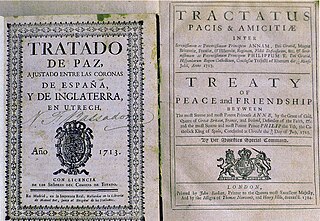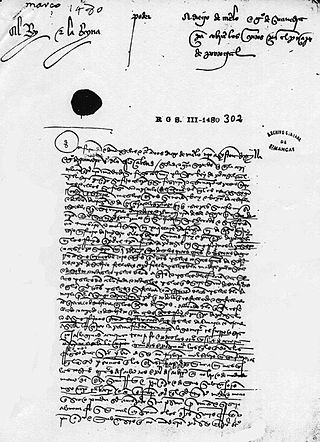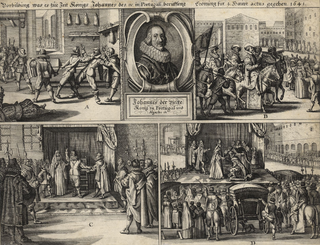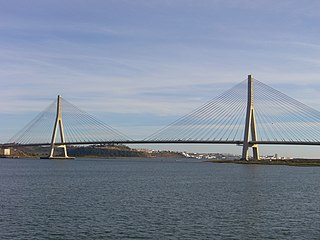External links
This article includes a list of references, related reading, or external links, but its sources remain unclear because it lacks inline citations .(May 2016) |
The Treaty of El Pardo was signed on 12 February 1761 between representatives of the Spanish and Portuguese empires.
Based on the terms of the treaty, all aspects of the Treaty of Madrid in 1750 were repealed. The reasons for this were the difficulties encountered in the 1750s to establish a clear border between the Spanish and Portuguese new South American possessions in such an enormous undeveloped area.
After both the Guarani War of 1756 and the accession to the throne of King Charles III of Spain in 1759, the Spanish king had decided that a general revision of the treaties made with Portugal was necessary.
This article includes a list of references, related reading, or external links, but its sources remain unclear because it lacks inline citations .(May 2016) |

The Treaty of Tordesillas, signed in Tordesillas, Spain, on 7 June 1494, and ratified in Setúbal, Portugal, divided the newly discovered lands outside Europe between Portugal and the Crown of Castile, along a meridian 370 leagues west of the Cape Verde islands, off the west coast of Africa. That line of demarcation was about halfway between Cape Verde and the islands visited by Christopher Columbus on his first voyage, named in the treaty as Cipangu and Antillia.

The Peace of Utrecht was a series of peace treaties signed by the belligerents in the War of the Spanish Succession, in the Dutch city of Utrecht between April 1713 and February 1715. The war involved three contenders for the vacant throne of Spain, and involved much of Europe for over a decade. The main action saw France as the defender of Spain against a multinational coalition. The war was very expensive and bloody, and finally stalemated. Essentially, the treaties allowed Philip V to keep the Spanish throne in return for permanently renouncing his claim to the French throne, along with other necessary guarantees that would ensure that France and Spain should not merge, thus preserving the balance of power in Europe.

The Spanish Empire, sometimes referred to as the Hispanic Monarchy or the Catholic Monarchy, was a colonial empire that existed between 1492 and 1976. In conjunction with the Portuguese Empire, it was the first empire to usher the European Age of Discovery and achieve a global scale, controlling vast portions of the Americas, Africa, various islands in Asia and Oceania, as well as territory in other parts of Europe. It was one of the most powerful empires of the early modern period, becoming known as "the empire on which the sun never sets". At its greatest extent in the late 1700s and early 1800s, the Spanish Empire covered over 13 million square kilometres, making it one of the largest empires in history.

The Treaty of Alcáçovas was signed on 4 September 1479 between the Catholic Monarchs of Castile and Aragon on one side and Afonso V and his son, Prince John of Portugal, on the other side. It put an end to the War of the Castilian Succession, which ended with a victory of the Castilians on land and a Portuguese victory on the sea. The four peace treaties signed at Alcáçovas reflected that outcome: Isabella was recognized as Queen of Castile while Portugal reached hegemony in the Atlantic Ocean.

The Viceroyalty of the Río de la Plata meaning "River of the Silver", also called "Viceroyalty of the River Plate" in some scholarly writings, in southern South America, was the last to be organized and also the shortest-lived of the Viceroyalties of the Spanish Empire in the Americas. The name "Provincias del Río de la Plata" was formally adopted in 1810 during the Cortes of Cádiz to designate the Viceroyalty of the Río de la Plata.

The Asiento de Negros was a monopoly contract between the Spanish Crown and various merchants for the right to provide enslaved Africans to colonies in the Spanish Americas. The Spanish Empire rarely engaged in the transatlantic slave trade directly from Africa itself, choosing instead to contract out the importation to foreign merchants from nations more prominent in that part of the world; typically Portuguese and Genoese, but later the Dutch, French, and British. The Asiento did not concern French or British Caribbean but Spanish America.

Inter caetera was a papal bull issued by Pope Alexander VI on the 4 May 1493, which granted to the Catholic Monarchs King Ferdinand II of Aragon and Queen Isabella I of Castile all lands to the "west and south" of a pole-to-pole line 100 leagues west and south of any of the islands of the Azores or the Cape Verde islands.

The Treaty of Madrid was an agreement concluded between Spain and Portugal on 13 January 1750. In an effort to end decades of conflict in the region of present-day Uruguay, the treaty established detailed territorial boundaries between Portuguese Brazil and the Spanish colonial territories to the south and west. Portugal also recognized Spain's claim to the Philippines while Spain acceded to the westward expansion of Brazil. The treaty included a mutual guarantee of support in case either state's American colonies were attacked by a third power.
Banda Oriental, or more fully Banda Oriental del Uruguay, was the name of the South American territories east of the Uruguay River and north of Río de la Plata that comprise the modern nation of Uruguay, the modern state of Rio Grande do Sul, Brazil, and part of the modern state of Santa Catarina, Brazil. It was the easternmost territory of the Viceroyalty of the Río de la Plata.

The United Provinces of the Río de la Plata, earlier known as the United Provinces of South America, was a name adopted in 1816 by the Congress of Tucumán for the region of South America that declared independence in 1816, with the Sovereign Congress taking place in 1813, during the Argentine War of Independence (1810–1818) that began with the May Revolution in 1810. It originally comprised rebellious territories of the former Spanish Viceroyalty of the Río de la Plata dependencies and had Buenos Aires as its capital.

The Portuguese Restoration War was the war between Portugal and Spain that began with the Portuguese revolution of 1640 and ended with the Treaty of Lisbon in 1668, bringing a formal end to the Iberian Union. The period from 1640 to 1668 was marked by periodic skirmishes between Portugal and Spain, as well as short episodes of more serious warfare, much of it occasioned by Spanish and Portuguese entanglements with non-Iberian powers. Spain was involved in the Thirty Years' War until 1648 and the Franco-Spanish War until 1659, while Portugal was involved in the Dutch–Portuguese War until 1663.

Dutch Ceylon was a governorate established in present-day Sri Lanka by the Dutch East India Company. Although the Dutch managed to capture most of the coastal areas in Sri Lanka, they were never able to control the Kingdom of Kandy located in the interior of the island. Dutch Ceylon existed from 1640 until 1796.

The Treaty of Fontainebleau was a secret agreement signed on 27 October 1807 in Fontainebleau, France between King Charles IV of Spain and the French Emperor Napoleon. Under the treaty, the House of Braganza was to be driven from the Kingdom of Portugal with the country subsequently divided into three regions, the north and south to be ruled by Duke of Parma and Spanish minister Manuel Godoy respectively, while the provinces of Beira, Tras-os-Montes and Portuguese Estremadura would remain in abeyance until a later peace. Within seven months the government of Spain had collapsed and two Spanish kings abdicated. In August 1808 Napoleon imposed his brother Joseph as King of Spain.

The Misiones Orientales or Sete Povos das Missões/Siete Pueblos de las Misiones is a historic region in South America, in present-day Rio Grande do Sul, the southernmost State of Brazil.
The Spanish-Portuguese War, also known as the Second Cevallos expedition, was fought between 1776 and 1777 over the border between Spanish and Portuguese South America.

Portugal and Spain enjoy a friendly relationship. They are both members of the Ibero-American Summit, Council of Europe, European Union, Eurozone, Schengen Area and NATO, and make up the vast majority of the Iberian Peninsula.

Ferdinand II was King of Aragon from 1479 until his death in 1516. As the husband of Queen Isabella I of Castile, he was also King of Castile from 1475 to 1504. He reigned jointly with Isabella over a dynastically unified Spain; together they are known as the Catholic Monarchs. Ferdinand is considered the de facto first king of Spain, and was described as such during his reign, even though, legally, Castile and Aragon remained two separate kingdoms until they were formally united by the Nueva Planta decrees issued between 1707 and 1716.

The Treaty of Zaragoza or Saragossa, also called the Capitulation of Zaragoza or Saragossa, was a peace treaty between Castile and Portugal, signed on 22 April 1529 by King John III of Portugal and the Habsburg emperor Charles V in the Aragonese city of Zaragoza. The treaty defined the areas of Castilian and Portuguese influence in Asia in order to resolve the "Moluccas issue", which had arisen because both kingdoms claimed the lucrative Spice Islands for themselves, asserting that they were within their area of influence as specified in 1494 by the Treaty of Tordesillas. The conflict began in 1520, when expeditions from both kingdoms reached the Pacific Ocean, because no agreed meridian of longitude had been established in the far east.

Brazil–Spain relations are the current and historical relations between Brazil and Spain. Both nations are members of the Organization of Ibero-American States.

The Portugal–Spain border, also referred to as "The Stripe", is one of the oldest geopolitical borders in the world. The current demarcation is almost identical to that defined in 1297 by the Treaty of Alcañices. The Portugal–Spain border is 1,214 km (754 mi) long, and is the longest uninterrupted border within the European Union, being free of border control since March 26, 1995, with a few temporary exceptions. The border is not defined for 18 km (11 mi) between the Caia river and Ribeira de Cuncos, because of the disputed status of Olivenza/Olivença, which has been disputed between the two countries for two hundred years.